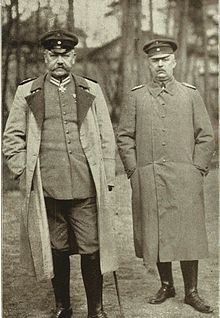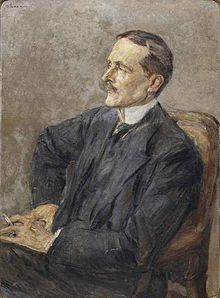Berlin Conference (March 31, 1917)
Arthur Zimmermann Paul von Hindenburg Erich Ludendorff The Berlin Conference of March 31, 1917, was a German governmental meeting designed to define a new direction for the Imperial Reich's[nb 1] war aims in Eastern Europe.
During March, Arthur Zimmermann, the German Foreign Minister, received fragmented updates on political events in Russia, specifically the monarch's overthrow.
[2] Aware of this reality, the Quadruple Alliance military planners promptly redeployed their armies to Italy, the Balkans, and the western front, which had hitherto been engaged in the East.
To mitigate the negative effects of this simultaneous dual confrontation, German diplomats proposed the creation of buffer states along the non-Russian borders of the Tsarist empire.
Chancellor Bethmann Hollweg and his ministers in September 1914 selected the regions to be controlled at Russia's expense, including Finland, the Baltic states, Poland, and Ukraine up to Rostov-on-Don.
[6] Reich Chancellor Theobald von Bethmann Hollweg did not physically attend the conference,[7] but it was opened and closed on his behalf by Arthur Zimmermann, State Secretary for Foreign Affairs, and his principal collaborators.
[8] The military command, led by the Dioscuri, Paul von Hindenburg and Erich Ludendorff, and their deputy Max Hoffmann,[7] who was known as the "essential man of the East" and was the main organizer of the Eastern Front, was also in attendance.
Meanwhile, the Reich Chancellor, supported by a majority of parties in the Reichstag, sought to initiate negotiations with the new Russian power in order to safeguard the conquered territories in Poland and the Baltic states.
Following Ulrich von Brockdorff-Rantzau's advice, while posted in Denmark, Arthur Zimmermann obtained the Chancellor's authorization not only to encourage pacifist propaganda in Russia but also to facilitate the return of the Bolsheviks.
[17][18] At the meeting, the maps of the Baltic States were assessed and the group developed a draft territorial plan for German colonization of Lithuania and the Curonian Spit.




